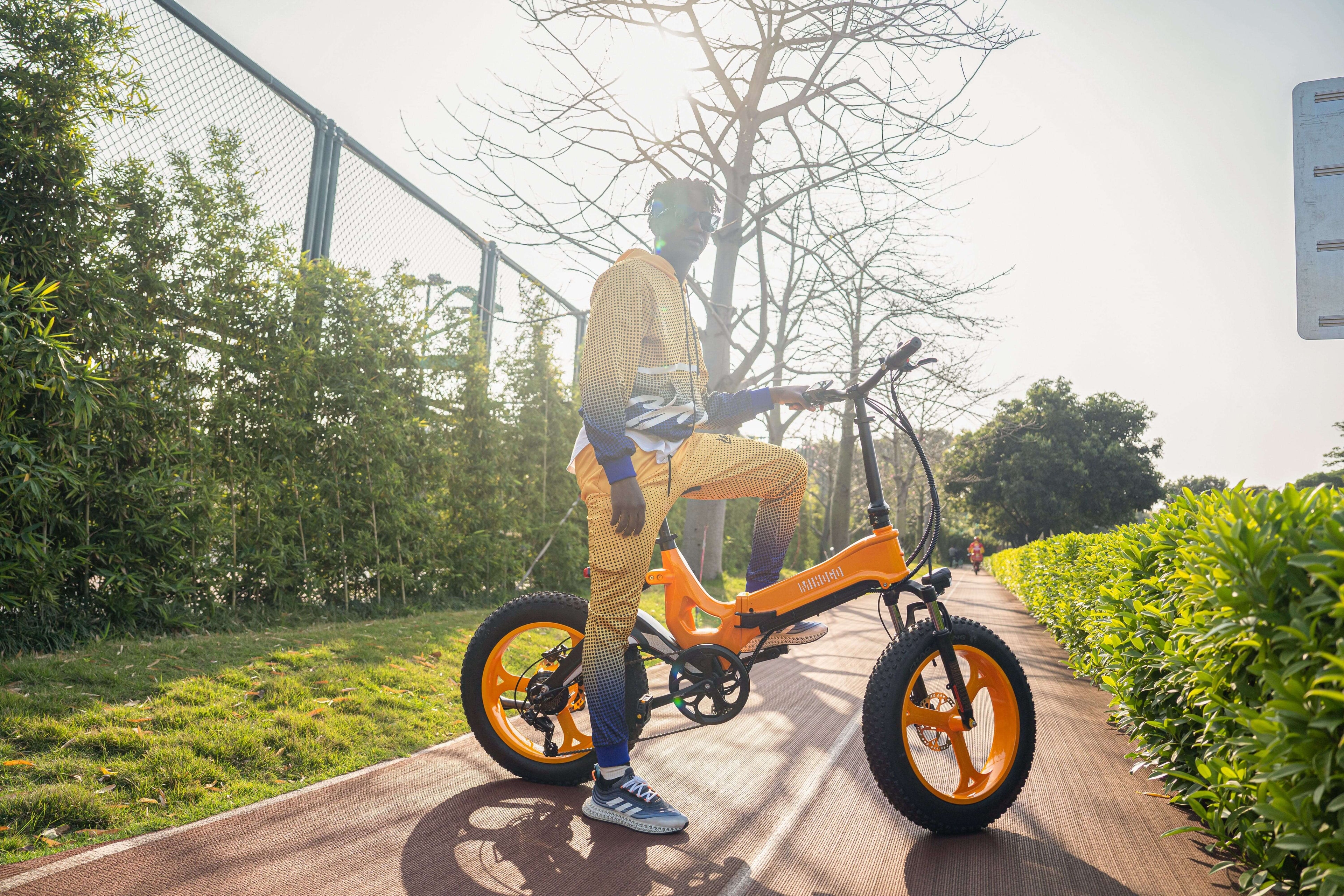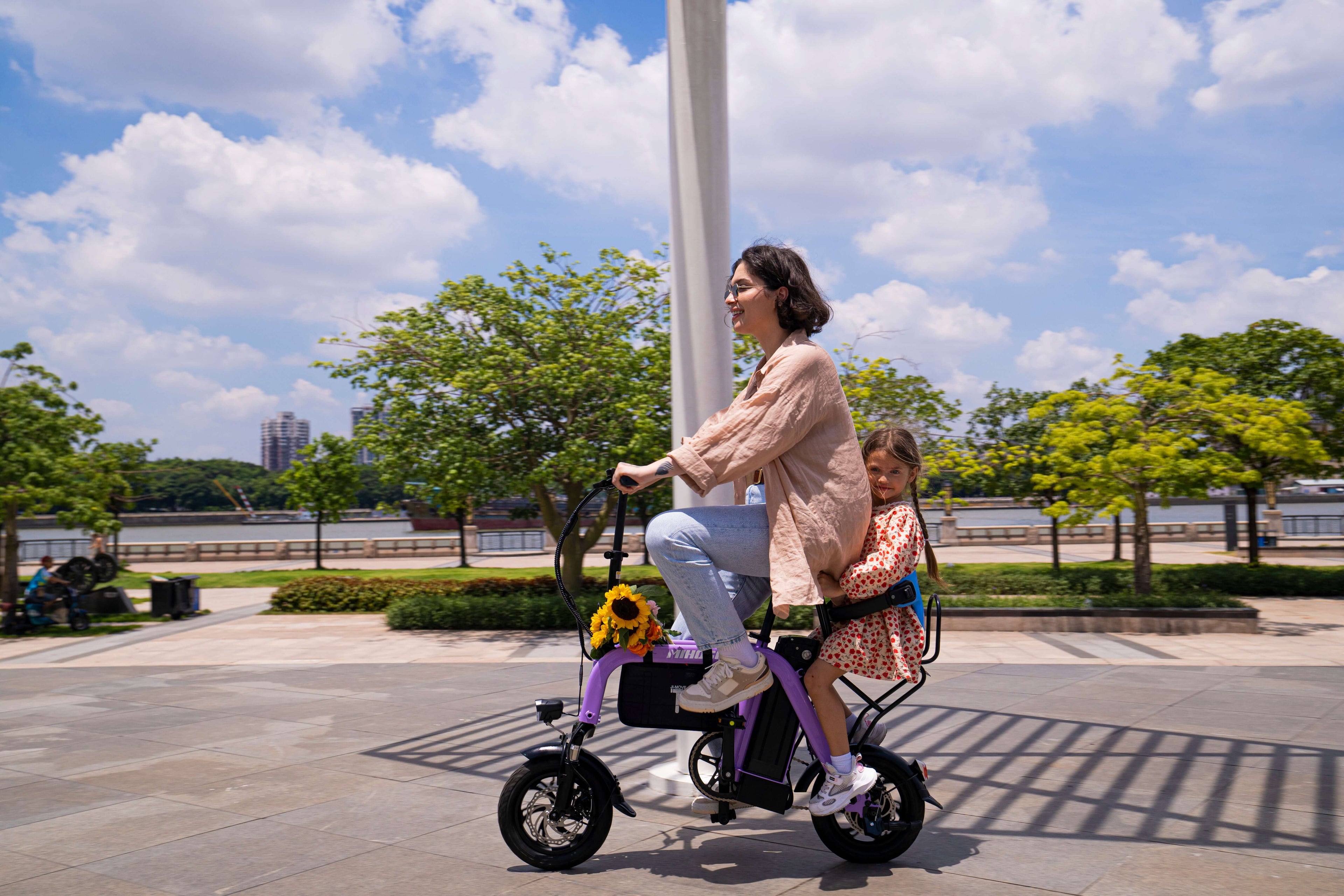Mihogo Model-Specific Battery Requirements and Terrain Considerations
Mihogo Air750 Max: High-Performance Carbon Fiber
- Motor Power: 750W | Range: 121 miles | Top Speed: 25MPH
- Battery Stress Factors: High power draw during acceleration, carbon frame heat dissipation
- Best Terrain: Road cycling, light trails, urban commuting with moderate hills
- Battery Considerations: Requires robust thermal management due to powerful motor
Mihogo ONE Utility: Heavy-Duty Workhorse
- Motor Power: 750W | Range: 167 miles | Top Speed: 25MPH
- Battery Stress Factors: Extended range cycling, cargo weight, frequent stop-start patterns
- Best Terrain: Urban delivery, cargo hauling, long-distance commuting
- Battery Considerations: Largest capacity battery requiring careful charge cycle management
Mihogo RX 2.4: Folding Commuter
- Motor Power: 500W | Range: 40 miles | Top Speed: 23MPH
- Battery Stress Factors: Folding mechanism vibrations, compact battery placement
- Best Terrain: City streets, bike paths, mixed transportation commutes
- Battery Considerations: Connection integrity critical due to folding stress
Mihogo Mini: Compact Urban Rider
- Motor Power: 350W | Range: 62 miles | Top Speed: 21.9MPH
- Battery Stress Factors: Compact cell arrangement, frequent short trips
- Best Terrain: Smooth urban surfaces, bike lanes, indoor storage areas
- Battery Considerations: Lower power requirements allow gentler discharge rates
Essential Battery Diagnostic Tools for Mihogo Owners
Primary Diagnostic Equipment
- Digital Multimeter - Most critical tool for voltage and continuity testing
- Infrared Thermometer - Detect overheating cells during charging/discharging
- Battery Capacity Tester - Measure actual amp-hour capacity vs. rated specs
- Insulated Gloves and Safety Glasses - Essential safety equipment
Advanced Diagnostic Tools
- BMS Interface Tools - Connect to Battery Management System for detailed diagnostics
- Smartphone Apps - Monitor real-time battery performance and charge cycles
- Load Testing Equipment - Simulate real-world power demands
Step-by-Step Battery Health Assessment
Phase 1: Visual Inspection Protocol
Before any electrical testing, conduct a thorough visual examination:
-
Battery Case Inspection
- Check for cracks, dents, or swelling in battery housing
- Look for water damage indicators or corrosion
- Examine mounting points for stress fractures
-
Connection Point Analysis
- Inspect battery terminals for corrosion or burn marks
- Check connector pins for proper alignment
- Verify secure electrical connections throughout system
-
Charging Port Evaluation
- Examine charging port for damage or debris
- Test charger connection fit and security
- Look for signs of overheating around charging area
Phase 2: Electrical Testing Procedures
Voltage Testing with Multimeter
Voltage testing is the most fundamental diagnostic procedure for e-bike batteries:
-
Resting Voltage Check
- Remove battery from Mihogo e-bike
- Allow 2-hour rest period after last use
- Measure voltage across positive and negative terminals
- Compare to manufacturer specifications for your model
-
Load Voltage Testing
- Connect battery to e-bike system
- Monitor voltage during motor operation
- Significant voltage drop (>5V) indicates cell degradation
-
Charging Voltage Verification
- Test charger output voltage before connecting
- Monitor battery voltage during charging process
- Verify voltage reaches proper cut-off point
Advanced BMS Diagnostics
The Battery Management System (BMS) regulates cell balance and protects against overcharging, over-discharging, and thermal issues:
-
BMS Status Indicators
- Check for error codes on display panel
- Monitor cell balance during charging
- Verify thermal protection activation temperatures
-
Cell Voltage Balance Testing
- Individual cell groups should vary ≤0.1V between cells
- Imbalanced cells indicate potential BMS reset need
- Document voltage readings for trending analysis
Common Battery Problems and Diagnostic Solutions
Problem 1: Reduced Range Performance
Symptoms: Noticeable decrease in riding distance on single charge, gradual or sudden range drop
Diagnostic Steps:
- Capacity Testing - Measure actual amp-hours vs. rated capacity
- Discharge Rate Analysis - Monitor power consumption during typical rides
- Temperature Monitoring - Check for overheating during discharge
- Charge Cycle Documentation - Track total cycles completed
Solutions:
- Recalibrate BMS if capacity shows significant variance
- Adjust riding patterns to reduce high-drain scenarios
- Consider cell balancing if individual cells show degradation
Problem 2: Charging Issues
Symptoms: Extended charging times, failure to reach full charge, charger disconnection
Diagnostic Steps:
- Charger Verification - Test output voltage and current delivery
- Connection Resistance Testing - Measure resistance at all connection points
- Thermal Analysis - Monitor battery temperature during charging
- BMS Communication Check - Verify proper communication between charger and BMS
Solutions:
- Clean corroded connections with DeoxIT contact cleaner
- Replace damaged charging cables or connectors
- Reset BMS by disconnecting battery for 10+ minutes
Problem 3: Intermittent Power Loss
Symptoms: Random shutdowns, power cutting out during rides, erratic motor behavior
Diagnostic Steps:
- Vibration Testing - Check connection security during simulated riding
- Connector Inspection - Look for loose or partially seated connectors
- Wiring Continuity Check - Test all power delivery paths
- BMS Protection Activation - Monitor for automatic safety shutoffs
Solutions:
- Secure all electrical connections with proper torque specifications
- Apply dielectric grease to outdoor-exposed connections
- Replace worn or damaged wiring harnesses
Preventive Maintenance Schedule for Mihogo Batteries
Weekly Checks (All Models)
- Visual inspection for physical damage
- Battery terminal cleaning and corrosion prevention
- Charge level monitoring and documentation
Monthly Diagnostics
- Voltage testing under load conditions
- Temperature monitoring during typical rides
- Capacity testing for trending analysis
Quarterly Professional Assessment
- Complete BMS diagnostic scan
- Cell balance verification and correction
- Thermal imaging of battery pack
Annual Deep Maintenance
- Professional capacity test and certification
- Complete electrical system audit
- Battery pack recalibration if needed
Terrain-Specific Battery Care for Mihogo Models
For Mihogo Air750 Max (High-Performance Road)
Road and Trail Optimization:
- Monitor battery temperature during sustained high-speed riding
- Use regenerative braking features when available
- Ideal for: Long-distance road cycling, moderate hill climbing, fitness riding
For Mihogo ONE Utility (Extended Range Cargo)
Urban Delivery and Long-Distance Use:
- Implement partial charging strategy for daily use cycles
- Monitor battery performance under heavy cargo loads
- Ideal for: Food delivery, cargo transport, extended commuting
For Mihogo RX 2.4 (Folding Flexibility)
Mixed Transportation and Storage:
- Check connection integrity after each fold/unfold cycle
- Store battery separately if folding for extended periods
- Ideal for: Multi-modal commuting, apartment living, travel
For Mihogo Mini (Urban Efficiency)
City and Indoor Applications:
- Optimize charging schedule for frequent short trips
- Monitor battery health with lower power demands
- Ideal for: Campus riding, short errands, elderly mobility
Advanced Repair Techniques and When to Seek Professional Help
DIY-Friendly Repairs
- Battery terminal cleaning and protection
- Basic connector replacement
- BMS reset procedures
- Charging system troubleshooting
Professional-Only Repairs
- Cell replacement or battery pack rebuilding
- BMS circuit board repair or replacement
- Internal wiring modifications
- Thermal management system repairs
Safety Warning: Never attempt to open lithium battery packs without proper training and equipment. Improper repair can cause fires or explosions.
Battery Storage and Longevity Optimization
Optimal Storage Conditions
- Temperature Range: 10°C-35°C (50°F-95°F) for best longevity
- Charge Level: Store at 40-60% charge for extended periods
- Humidity Control: Dry environment prevents corrosion
Charging Best Practices
- Use only manufacturer-approved chargers for your Mihogo model
- Avoid charging in extreme temperatures
- Unplug charger when battery reaches 100% capacity
- Implement partial charging cycles for daily use
Cost-Effective Battery Replacement Planning
When to Replace vs. Repair
- Replace when capacity drops below 70% of original
- Repair if issues are connection-related or BMS failures
- Consider upgrade options for improved range or power
Budgeting for Battery Replacement
Monitor these indicators to plan replacement timing:
- Gradual range reduction over 6+ months
- Increasing charging times or charging failures
- Multiple cell imbalances requiring frequent BMS resets
Conclusion: Maximizing Your Mihogo Battery Investment
Proper battery diagnostics and maintenance can extend your Mihogo e-bike battery life by 50-100%, saving hundreds of dollars in premature replacements. By following this comprehensive guide and implementing regular diagnostic routines, you'll ensure reliable performance whether you're commuting on your RX 2.4 or adventuring with your Air750 Max.
Remember: Early detection of battery issues prevents catastrophic failures and maintains the resale value of your Mihogo e-bike. When in doubt, consult certified e-bike technicians for professional diagnosis and repair.
Related Resources:
- Understanding Lithium Battery Technology - Wikipedia comprehensive battery science reference
- E-Bike Safety Guidelines - Consumer Product Safety Commission official guidance
- Battery Recycling Programs - EPA environmental disposal guidelines








